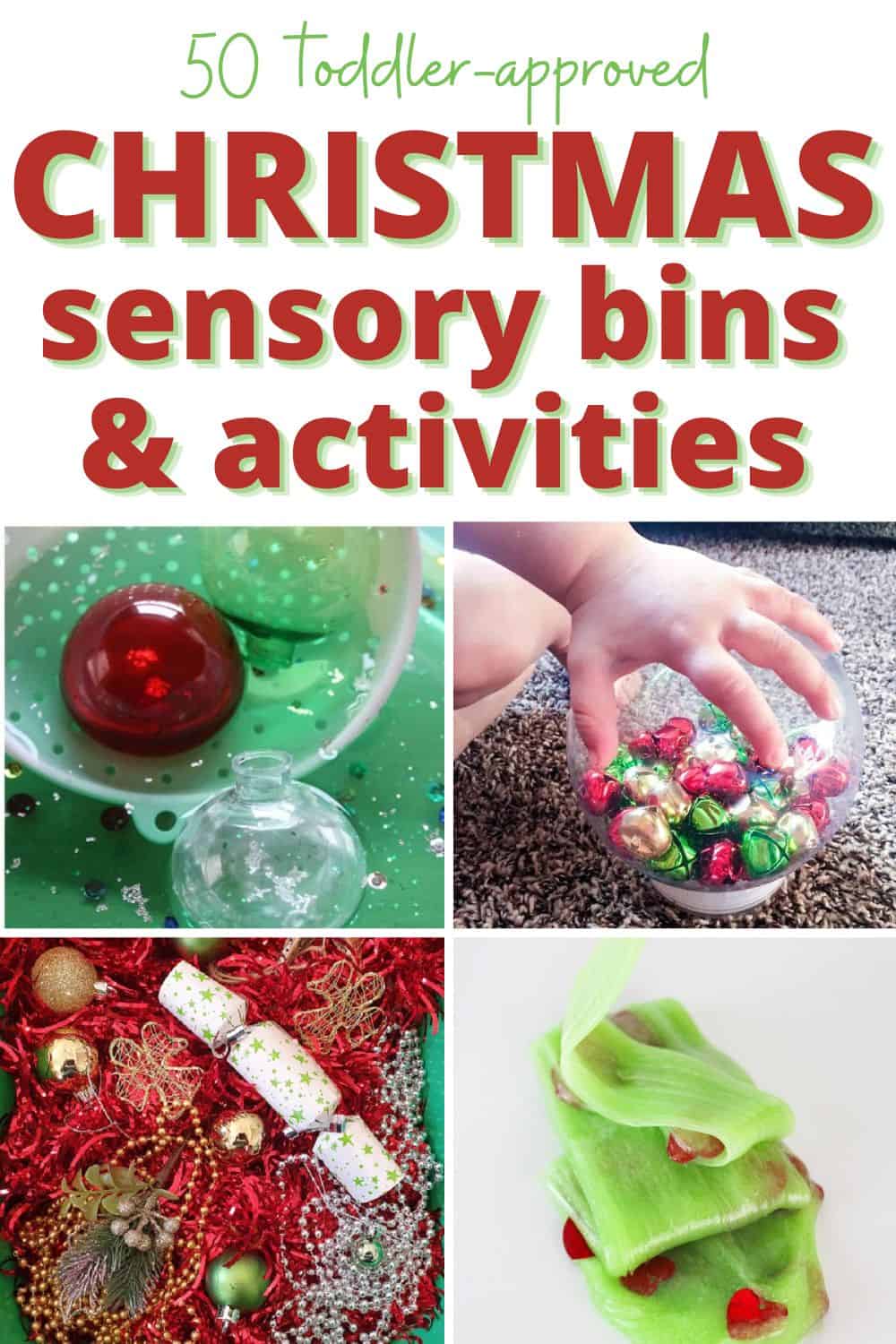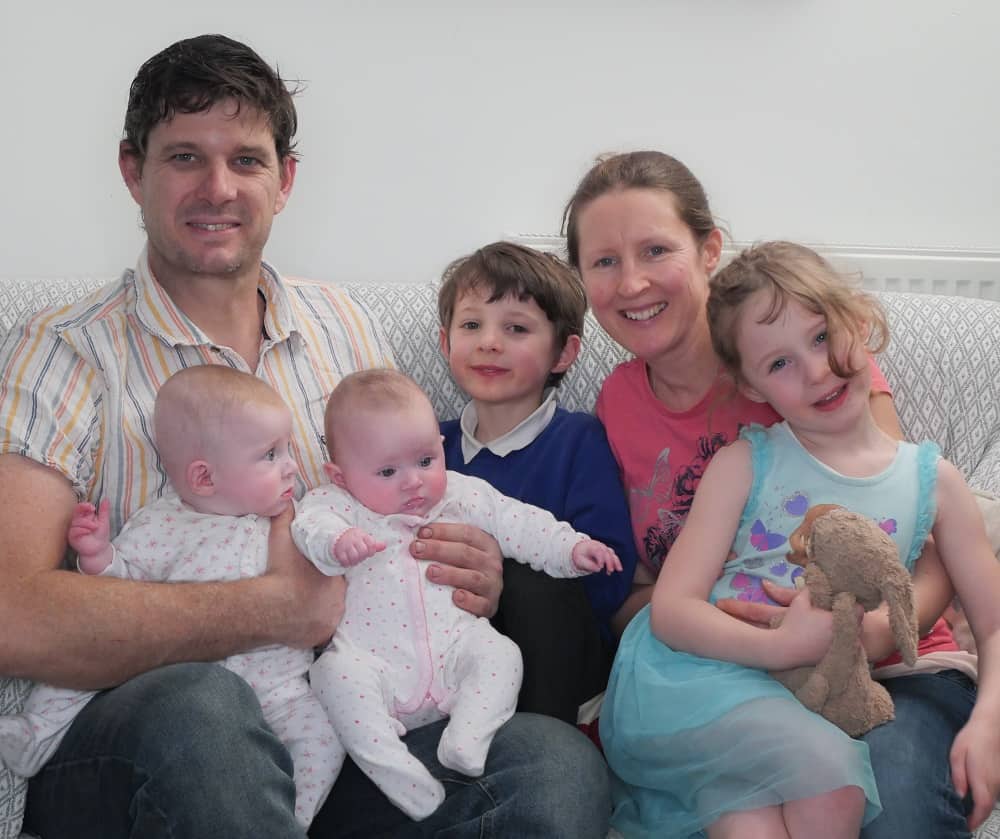The newborn phase is a toughie, made all the more difficult when your baby won’t sleep in their bassinet but wants to nap on you. Learn how to get a newborn to sleep in a bassinet, instead of behind held in your arms, right here.
If you’re reading this one-handed while your newborn is curled up, snoring softly on your chest, but you’re desperate to get up to take a pee/relieve your crooked neck/feed your growling stomach or actually lie right down and properly rest… you’re in the right place…
You need to know how to get your newborn baby to sleep in her bassinet instead of your arms.
These are moments to cherish, of course, and cherish them you do. But oh, wouldn’t it be just wonderful if your little angel would just take a nap in that beautiful bassinet you spent so long choosing?! Just occasionally?
But you’ve almost given up trying. The dreaded bassinet transfer is never successful and your newborn wakes as soon as you put her down. Those tiny eyes pop open, begging to snuggle back onto your chest or into the crook of your arms.
So you continue to sit, motionless, coffee out of reach, neck jammed awkwardly to the side, sweating under that tiny furnace of a human being.
And wait.
But fear not, finally some solutions that work. At the end of this post you will know how to get your newborn baby to sleep in a bassinet instead of your arms. Pinky promise.
Table of Contents
ToggleNewborn won’t sleep in bassinet?
If you look at the environment in which your newborn was used to sleeping, you’ll soon see why your baby will not sleep in a bassinet. You’ll see why your arms are so inviting. The contrast between the womb and the big wide world, including the bassinet, is pretty stark.
Your newborn’s environment pre-birth
Your baby was warm and cosy, tightly coiled inside you, with the consistent rhythmic sounds of your body in the pitch black.
Out in the big wide world
Your little one is exposed to bright lights, cold drafts and just so much freedom for those flailing arms and legs. Plus a whole lot of smells.
The bassinet
You probably have baby’s bassinet in a warm and cosy room and hopefully, dim the lights. Those are some of the basics to getting your baby to sleep in a bassinet.
However, it’s a far cry from the warmth and snugness of your arms, the sensation of your beating heart and the rise and fall of your chest…
So if your newborn will not sleep in the bassinet and you need to know how to get her to sleep anywhere but your arms it’s all about replicating those calming and soothing sensations. The tips coming up later will tackle exactly how to get a newborn to sleep in a bassinet.
Other reasons why your baby won’t sleep in the bassinet
Physical needs aren’t met
Getting a newborn to sleep in the bassinet may be as simple as fulfilling their physical needs. Are they hungry? Newborns feed a lot in the early weeks and months (every 2-3 hours) and go through frequent growth spurts when they’re even hungrier. You may only have finished feeding your baby half an hour ago, but they may be ready to eat again!
While they’re tired and content to sleep in your arms, they will want to keep you in reach until their hunger is satisfied. Nature’s way of ensuring survival So if your newborn won’t sleep in the bassinet, check if they’re hungry.
The same goes for a dirty diaper. You’re going to have a hard time getting your newborn to sleep in a bassinet if they need a change.

Baby is over or undertired
Baby’s need to stay awake long enough to be tired enough to fall asleep, just like us. The tricky bit is knowing when exactly that is.
Sadly, it’s not as easy as waiting until your newborn is fussing and irritable and clearly tired. At this point your baby is almost certainly overtired. Getting a newborn to sleep in a bassinet that’s overtired will be almost impossible.
If your newborn baby won’t sleep in a bassinet keep a close eye on their “awake times“. This is the time they’ll happily stay awake before becoming overtired.
For a newborn baby under 3 months of age, awake times will be short, between 45 minutes and 1.5 hours. That includes the time spent feeding. Beyond watching the clock, look for tiredness cues: staring into space, avoiding eye contact, lying still. Once you see those sleep cues, don’t delay getting baby settled to sleep.
Check out this post for more details: Awake times & the 3 tactics to avoid an overtired baby
The Moro reflex wakes them
The Moro reflex is a newborn reflex with little purpose in modern-day man and irritatingly can jump your little one wide awake in a nano second. While you hold them in your arms, the Moro won’t disturb them.
You may also inadvertently trigger the Moro reflex when trying to lay them in the bassinet. You may need to be more strategic at getting your newborn to sleep in bassinet. The sensation of falling can trigger the Moro, for example by lowering them too fast.
In addition, put them down bum first, rather than head first. This will minimize any falling sensation.
Your baby is used to sleeping in your arms
For newborns under 3 months old, sleep habits and associations have yet to form. Although your arms may be the most comforting and soothing, it’s unlikely that this is habitual.
Between 3 and 4 months, babies become more alert and their sleep cycles become more distinct. This is when they can become attached to certain sleep props or aids, such as sleeping in your arms, which become sleep associations. Once used to sleeping in your arms, they will want to continue to fall asleep exactly the same way.
The tips below that’ll teach you how to get a newborn to sleep in a bassinet will help your baby make different habits. “Positive associations” that don’t rely on your arms!
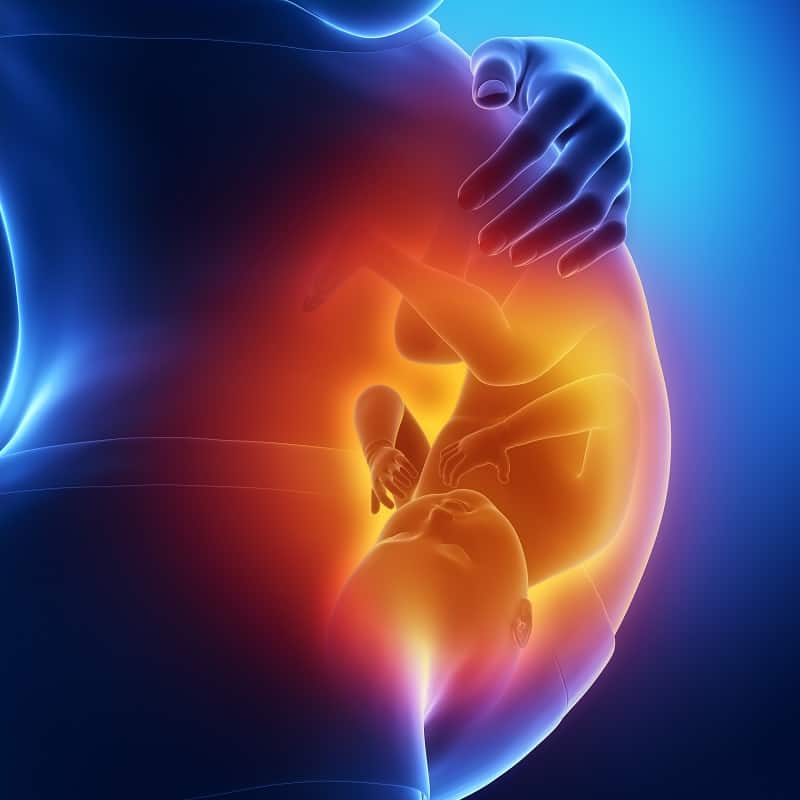
The “fourth trimester” – its effect on sleep and baby’s ability to fall asleep
Wait, fourth trimester I hear you say? There’s widespread belief that newborns would have been better off staying put a little longer in the womb, an extra 3 months in fact. This would allow time for further development, making the transition into the big wide world easier.
During the “newborn phase”, baby is in need of almost, round-the-clock nourishment and nurturing, as you can’t fail to have noticed. So much so that it’s pretty much an extension of gestation, but outside of the womb. Hence the term “fourth trimester” coined by well-known pediatrician and author, Dr. Karp.
Looking at the developmental progress a newborn makes during this phase, this seemingly early entry into the world makes life one heck of a challenge for baby, and for mom. (Not that we’re ready to leap to our feet and flee attacking predators at the 3-month mark either, but still…)
Sight
At birth: baby has difficulty focusing and is unable to track an object
By 3 months: can focus, follow and recognize moving objects and people
Movement and coordination
At birth: newborn reflexes provide controlled movement in response to specific stimuli but other movement is erratic with no coordination
By 3 months: can use hands and eyes in coordination – clutching and grasping, bringing hands to mouth – can support head and raise it when lying on front
Social skills
At birth: communication of needs via tears
By 3 months: smiles when happy (before social smiling, newborns have a “windy” smile, an early wind cue, one of several must-know baby cues), imitates and babbles (the first stages of learning to talk)
Sleep
At birth: erratic sleep patterns, super short naps, super long naps and everything in between, irregular sleep cycles, a lot of “active” sleep (equivalent to REM sleep in adults when brain is very active) so baby is disturbed and wakes very easy, baby drifts easily between sleep cycles
Around 3 months: sleep starts to mature; sleep patterns become a little more predictable, cycles have a little less “active” sleep but baby is likely to come into full consciousness between cycles (meaning sleep often regresses and hence this maturation is commonly termed the 3-4 month sleep regression)
Related post: Newborn sleep patterns: decoded and demystified for healthy sleep habits
Self-settling (i.e. the ability for baby to soothe herself when distressed and settle herself to sleep)
At birth: baby needs help to soothe herself if upset and will often need help falling asleep and back to sleep on waking
Around 3 months: baby is able to soothe herself (by actively looking to suck on fingers, thumb, paci, avoid stimulation by turning head away and staring into space) and fall asleep alone (although may need encouragement at first)
Related post: Rooting to suck: is baby really hungry? And why you need to know (Hint: beware the comfort feed)
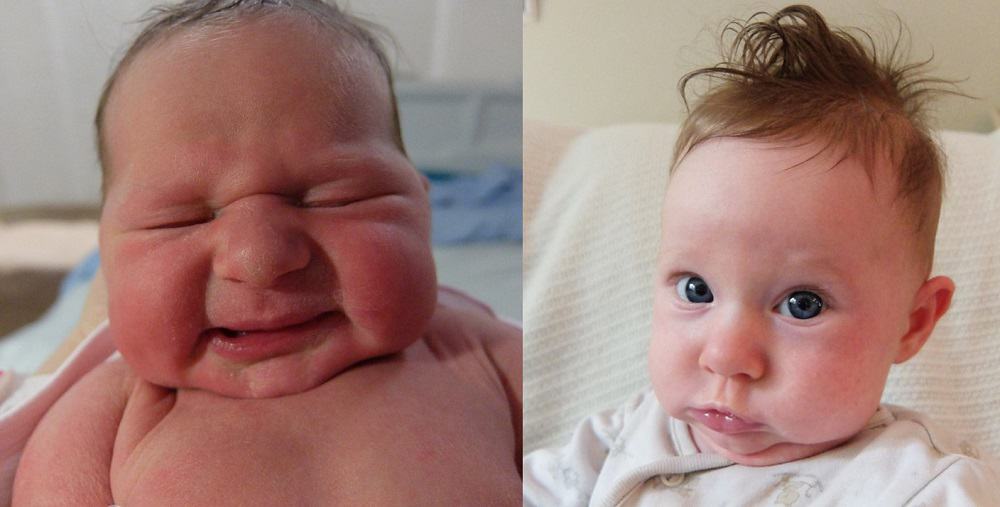
So why the need for babies to struggle through the fourth trimester?
Well, if you thought childbirth was one heck of a squeeze and a strain, can you imagine an extra 3 months of growth before getting started? Yeah, me neither. Those big brains of ours mean an early exit is the only way.
Getting a newborn to sleep in a bassinet – SETTLING & SOOTHING PRINCIPLES
Learning how to get a newborn to sleep in a bassinet instead of your arms starts by understanding the sensations you’re trying to replicate.
The sensations that soothed, calmed and helped settle baby to sleep when inside the womb are your starting point for getting a newborn baby to sleep in the bassinet or anywhere else
Calming & soothing sensations versus stimulating & irritating ones – sense by sense
VISUALS
There’s almost zero light exposure in the womb.
Soothing on the eyes
Low lighting, soft pastels and muted colors.
Visuals that stimulate
Bright colors and bright lights can irritate but a newborn will enjoy looking at shapes and contrasting images (particularly faces) while learning to focus.
SOUND
Your heartbeat and gurgling, whooshing noises from inside the body. Volume level is said to be a little louder than a vacuum cleaner.
Soothing sounds
Gentle, rhythmical sounds and the dull consistency of white noise.
Sounds that stimulate
Irregular sounds and loud noises may stimulate and irritate.
TOUCH
Baby is enveloped in the warm and close confines of the womb.
Soothing touch
Deep-touch pressure, especially to the back, at a comfortable temperature
Touch that stimulates
- rough textures
- soft touches
- a light breeze
- hot and cold touches
- unfamiliar touches
MOVEMENT
Baby is constantly moved and rocked during pregnancy with large movements when you’re moving about as well as much smaller movements 24/7 due to pressure from the diaphragm as you breathe.
Soothing movement
Gentle, rhythmical movements particularly while positioned on the front or side will be soothing
Movement that stimulates
Irregular, quick and jerky movements will alert or even irritate.
TASTE & SMELL
Baby is used to the neutral smells and flavors of the amniotic fluid.
Soothing tastes and smells
The sweet taste of breast or formula milk
Soothing smells: mom and mom’s milk (or before mom’s milk comes in, colostrum, the precursor to milk), the smell of dad or other regular caregivers as well as baby’s own smell and saliva
Smells that stimulate
New and different smells will stimulate your baby but can easily irritate. A particularly strong or unpleasant smell or too many new smells at once may cause your baby to suck, cry, or breathe more rapidly.
(Taste isn’t applicable since baby is only drinking milk.)
POSITION
Baby was in all sorts of different and obscure positions in the womb, mostly side and stomach lying ones, before normally migrating to the head down position when nearing delivery.
Soothing positions
Side or stomach lying positions, not only because this is the closest to the position baby was in the womb, but also help reduces discomfort due to gassiness.
Positions that can stimulate or irritate
Lying on the back. Bad news of course, since “Back to Sleep” is the recommendation (front and side-sleeping runs the highest risk of SIDS).
Use side of stomach lying positions to soothe and calm only –once baby is asleep, gently roll her onto her back.
SUCKING
Not a sense in itself but the action of sucking combines several soothing sensations that can be a winning formula when it comes to calming and settling a newborn.
Incredibly, thumb and finger sucking can start before birth. Fingers/thumb and mouth just happen to come into contact, stimulating the rooting and suck reflex.
The sucking action itself is extremely calming and soothing, add to that the sweet taste of breastmilk and the smell of mom/another caregiver close by delivering that liquid gold, and you have almost an instant calmer.
How to get a newborn to sleep in a bassinet instead of your arms – THE BASICS
As mentioned above, getting your newborn to sleep in a bassinet starts by going back to basics and nailing those womb-like sensations. These will soothe, calm, prepare for and ultimately help induce sleep. You’ll want to use these first few tips to put your baby to sleep anywhere, including the bassinet.

#1 Swaddle – aka wrap baby up like a burrito
Having been tightly curled up in the womb for so long, complete freedom of arms and legs will feel very insecure to your newborn. Swaddling restricts movement and creates deep pressure touch, calming and settling baby. It recreates the cocooning feeling baby was so accustomed to in the womb.
Swaddling also has an important secondary purpose: to prevent the Moro reflex, that startles newborns awake.
The lack of a neat and snug swaddle could definitely be a factor in your baby waking up as soon as you put her down in the bassinet. So get swaddling!
Related post: What’s better: A swaddle or sleep sack for a newborn?
Top swaddle tips
- An effective swaddle needs to be secure and snug with just enough room for you to fit 2 fingers inside at the chest
- Practice on a friends baby, doll or when your own baby is sleeping
- Newborns often scream blue murder at the sight of the swaddle; it doesn’t mean they hate it! Once on, and you’ve got it snug and secure you should find baby calms instantly
- Make sure your swaddle blanket is large enough – you won’t be able to secure it well and keep baby snug if it’s too small
- For those little escape artists, ensure arms are straight and flat to baby’s side or try double swaddling
- Keep botching your baby burritos? Try a fancy swaddle that does all the hard work for you – there are a tonne on the market and some great no-nonsense reviews, such as this one.
- For hip-healthy swaddling, allow plenty of movement around the hips and legs
For a short, sweet and effective how-to-swaddle guide, with video tutorials and printable cheat sheets, check out Keep That Swaddle On, our free mini-course.
#2 Make sure baby’s sleep environment is pitch black
Mimicking the visual and sound sensations experienced in the womb, baby’s sleep environment i.e. the room in which the bassinet is, needs to be pitch black.
This means so dark that you can’t even see your hand in front of you. Remember, baby came from pitch black so the dark is a comfort. Even in the day, the sleep zone needs to be pitch black – it’s not going to hinder your baby learning the difference between day and night.
This is relatively straightforward to accomplish with some good blackout curtains.
Related post: 18 Best Blackout Shades/Curtains For Baby’s Nursery
#3 Try white noise
In terms of replicating the intensity and type of noise your baby would have experienced in the womb, white noise is the best. But not all white noise is equal; it needs to be:
- low-pitch (think the low, rumbly and monotonous drone of the car engine)
- loud around 60-75 dB (think vacuum cleaner or loud shower)
Free white noise options
There’s plenty of choice when it comes to white noise specifically designed to calm, soothe and create the perfect noisy sleep zone for babies on youtube, as well as streaming services like Apple Music. Here’s one from youtube. Just remember to turn it up enough (shower or vacuum cleaner levels).
White noise machines to buy
If you’d rather buy a white noise machine here are two options that come with rave reviews (both are affiliate links):
Hatch Baby Rest Sound Machine, Night Light and Time-to-Rise – with white noise and audio monitor for the baby stage, night light for the toddler years and a changing color waking system for school years this’ll be a good investment
Yogasleep Rohm Portable White Noise Machine for Travel – small and portable for when you’re on the move.

#4 Adopt a good wind-down routine
5-10 minutes before a nap or sleep time or when baby is starting to show signs of tiredness, you want to start winding down. Wind-down needs to be short and sweet, calm and relaxed and something easily repeatable, so that over time it’ll help tell your baby that it’s time to sleep.
The first steps involve setting up that magical sleep zone and getting baby nicely wrapped up:
- Take baby to the room where she’ll sleep or another calm environment, keeping lights dim while you’re winding down
- Check and change diaper as necessary
- Swaddle baby
- Turn white noise on
(You can add a bath at the beginning of your wind-down once you’ve started bathing baby daily – the above steps would follow on from the bath.)
Then it’s about adding in the other soothing sensations of movement and smell as well as offering baby the ability to suck, if she’s a sucky baby that finds it soothing:
- Rock, swing and sway, holding baby close – you’ll almost certainly be doing this anyway since it’s just our natural instinct to do so as moms
- Offer baby a final breastfeed, bottle feed or a paci
You can do this until baby is drifting off but still awake or until baby is fully asleep.
In case you’re wondering, there’s no risk of sleep associations developing by aiding baby to sleep during the fourth trimester – these only develop once sleep starts to mature at that 3-4 month mark.
The final step:
- Put baby in her bassinet, say good night and moving swiftly and with stealth, exit the room
Of course, this is where you’re coming unstuck – but this is what you’re aiming for, and get there you will.
#5 Try initiating the “Calming Reflex”
Sometimes standard wind-down tactics are not going to cut it with a newborn who’s fussy, uncomfortable or overtired. This means you might get baby to fall asleep in your arms easily enough but baby wakes up as soon you put her down.
Enter the “calming reflex”, which quickly calms and soothes the fussiest baby to sleep, by a specific combination of touch, sound, visuals, taste, smell and position – the thought is that this reflex was almost continually switched on in the womb, keeping baby calm and fuss-free.
You just need to find the “on” button now your newborn has arrived. Sounds simple right? Surprisingly, it normally is.
Dr. Karp’s 5 S’s
Dr. Harvey Karp believes his specific calming method, the 5s’s, when carried out together and in a particular way should trigger a newborn’s calming reflex. It kind of sends baby into a trance, instantly calming baby and inducing sleep.
The 5s’s are as follows:
- Swaddle
- Side or stomach position
- Shush
- Swing
- Suck
Swaddling, shushing (by way of white noise), a swinging motion and sucking are covered by that magical sleep zone and the period of wind-down. But Dr. Karp’s swing is very specific…
The Swing or “Jell-O head jiggle”
Dr. Karp claims that slow, gentle movements won’t be enough to calm a fussy baby, but small, quick movements will, in a maneuver he calls the Jell-O head jiggle:
“For many babies, the Jell-O head jiggle is key to calming (quick little movements like a bobblehead). To do it, always support the head/neck, keep your motions small; and move no more than 1 inch back and forth.”
Watch this in action below.
You may find the 5 S’s so effective in settling baby to sleep, you’ll have more success in transferring baby to her bassinet. If not, fear not – there are more things to try.
How to get a newborn to sleep in a bassinet – UP THE SOOTHING WITHIN THE BASSINET
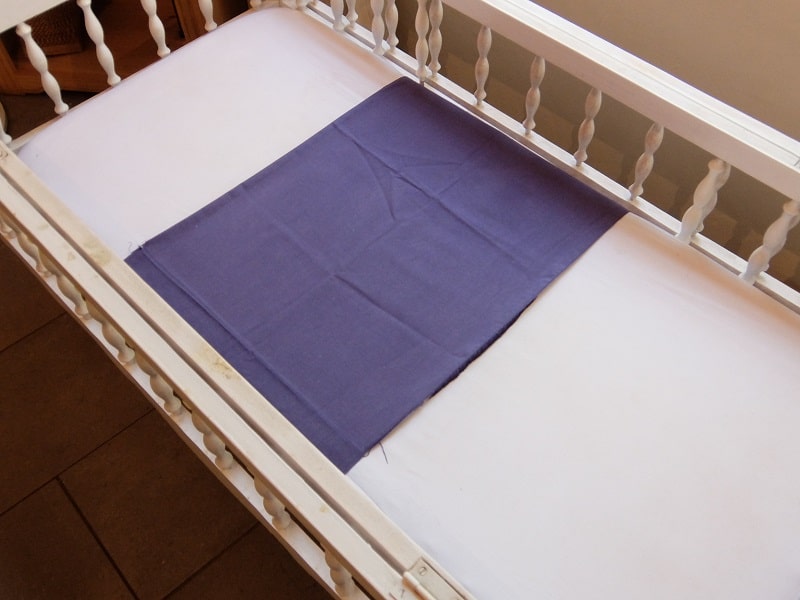
#6 Introduce yours and your baby’s smell into the bassinet
Your smell
Safe sleep guidelines include no loose items in the bassinet with baby, but you can easily add your familiar smell by using an unwashed pillowcase or large T-shirt of yours as an extra sheet within the bassinet. Tuck either end around the sides of the mattress, under where your baby will be lying.
This also acts as a “burp sheet”, great if you have a baby that spits up a lot or suffers from reflux; instead of having to change the whole sheet, you can often just get away with replacing the top sheet/your pillowcase or T-shirt.
Baby’s smell
Babies not only find mom and dad’s smell soothing and comforting, but their own smell can also do the trick, as mentioned earlier.
The trick here is not to overwash bedclothes and baby’s jammies. Obviously, the stink of sour milk is not what you’re going for, but a little bit of dribble here and there can provide that missing element of familiarity that can help in getting your newborn to sleep in her bassinet instead of your arms.
In addition, place your newborn in the bassinet at other non-sleep times. This will allow some transfer of her own smell into the bassinet and increase her familiarity with this specific environment.
#7 Warm the bassinet first
Even with a nice cosy swaddle, the absence of your warm arms and chest could be a factor in why your newborn will not sleep in the bassinet and wakes up as soon as you put her down. Try warming the bassinet beforehand with a hot water bottle.
THIS MUST BE REMOVED BEFORE PLACING BABY INTO THE BASSINET.
This is a very simple thing to try and could help in getting your newborn to sleep in the bassinet.
#8 Try the washcloth trick
No time for a hot water bottle? The most critical part of a coolish bassinet is where your baby’s head will lie, since the head is bare. (Hats are not deemed safe for sleep indoors due to the risk of overhearing.)
The washcloth trick can work wonders in getting baby to sleep in the bassinet instead of your arms.
While baby’s falling asleep in your arms, head in your hand, place a small washable wipe/face cloth between your hand and baby’s head. The wipe will be warm in your hands.
When you transfer baby, slide your hand from under baby’s head, leaving the warm wipe in the bassinet.
THIS NEEDS TO BE REMOVED BEFORE LEAVING
So wait until baby is settled in the bassinet and has warmed it up with her own body heat, then slide it out.
#9 Raise baby’s legs into the fetal position once in the bassinet
To reduce the risk of SIDS (Sudden Infant Death Syndrome), unfortunately, back sleeping is essential. However, by helping your newborn adopt more of a fetal position she should be a little more comfortable and you may have more success getting baby to sleep in the bassinet. She’ll be less likely to wake up as soon as you put her own.
Keeping within another key safe sleep guideline – no loose objects in the bassinet – is where it gets tricky, but definitely worth a try if you want to figure out how to get your newborn to sleep in the bassinet instead of your arms.
So, fold a small towel into a square block and place it under your baby’s legs, INSIDE THE SWADDLE. That’s the tough part of the maneuver since you can only do this easily once baby is sleeping in the bassinet and, of course, you just might not get to that point.
Another option is not to put it inside the swaddle, but under it, so it is then a loose item in the bassinet. In which case you’re going to have to stay nearby for the entirety of the nap.
Pointless! You may think – not much advantage to baby sleeping in your arms, right? But, give it a few days and once you’re regularly getting your newborn to sleep in the bassinet instead of your arms and you’ve formed a new habit, you can simply remove the towel.
#10 Try a sack of dry rice for extra deep pressure touch
There are a few pictures of this one in action on Pinterest – a rubber glove filled with dry rice, lying on top of a happy sleeping newborn – in a bassinet instead of mom’s arms. The dry rice increases the deep pressure touch, mimicking a fully enveloped hold or your hand resting on baby.
So if baby wakes up when you take your hand away, this one is a must-try.
Although it makes a great picture, the rubber glove is not of course essential. An un- or part-opened and well-sealed bag of rice wrapped in a towel will do the job nicely.
However, this is definitely one that goes against safe sleep guidelines, so you’ll have to watch over while your baby sleeps if you try this one. Again, if this does the trick in getting your baby to sleep in the bassinet rather than your arms, and you can make it the new norm, then you can remove the rice sack.
I’d definitely recommend removing it gradually, by reducing the amount of rice in it day by day, to gradually reduce the deep pressure touch. That way your baby should continue to happily stay asleep in the bassinet.
#11 Give the tissue trick a go
Bit of a random one – and one where you’re not making the bassinet any more comfortable or womb-like. In fact, I’m not entirely sure why or how this works but when I randomly came across it, it just had to be added to the list. So, for whatever reason, a tissue wafted over a newborn’s face often puts them to sleep. Check the video to see just how.
How to get a newborn to sleep in a bassinet: PRODUCTS TO TRY
#12 A sleep nest
Not a sleep positioner, a sleep nest.
A sleep positioner normally involves a wedge and/or extra padding that you can adjust to put baby in a specific position which goes against safe sleep guidelines. If any of the padding comes unstuck and baby manages to move from that position there’s a higher chance of SIDS from suffocation.
A sleep nest is an ergonomically shaped mattress , allowing baby to lie in a fetal-like position but still on their back. It was the one thing that worked consistently when getting my newborn to sleep in her bassinet instead of my arms. I simply placed it inside the bassinet or crib.
We had the Cocoonababy baby nest, pictured above, and not only did she stay asleep when I put her down, but she stayed asleep for longer stretches. This was also because she suffered from acid reflux and hated being on her back whether awake or asleep. As you can see in the picture she was very content in the Cacconababy.
(It’s also extremely portable and great for train and plane journeys when you’re desperate to put baby down and there’s nowhere safe and without risk of falling, other than a grubby floor).
Please investigate any sleep products very carefully and ensure they meet the safe sleep guidelines. The Lullaby Trust advises against sleep positioners or wedges and recommends that babies sleep “on a firm flat mattress, in a clear cot free of pillows, toys, bumpers and sleep positioners.” Check out their safe sleep product checklist for more details.
#13 A fancy swinging (and all singing, all dancing) bassinet
Ok, so lots of simple bassinets swing, but normally stop when you stop pushing them. Time to look upwards to the Bugatti of a bassinet: The Snoo.
The following is not based on my own experience, but on the views of satisfied customers and information from the sales page. The above link is not an affiliate link either.
The Snoo bassinet really is all singing and all dancing. Well, all shushing and swinging.
With 5 different sound and motion combinations, you’re sure to find a combination that’ll work in getting your newborn to sleep in this bassinet instead of your arms, which will be free to do other things.
Of course, this level of superiority comes with a hefty price tag that’ll make your eyes water (think upwards of $1,000) but there is now the option to rent one by the month, currently at a much more reasonable $129 a month. Still a bit of an ouch.
But the pain of next to no sleep with a baby who only sleeps in your arms could push you to trying it.
But, hold your horses, keep your money in your purse until you’ve tried the 12h and final solution to get your newborn to sleep in her bassinet instead of your arms…
Getting baby to sleep IN the bassinet instead of your arms: ELIMINATING THE “PUT DOWN”
I’ve possibly saved the best until last here – if you can put this one into practice, you’ll be away. Literally and metaphorically.
This one eliminates the need to “put baby down” at all. When you think about it, it makes perfect sense: why try to transfer your newborn while asleep, why not try settling baby to sleep once in the bassinet?

#14 Settle your newborn in the bassinet, then there’s no need to transfer baby once asleep
So putting this into practice, might not exactly be an easy ride, but it will be worth it.
First of all, back to those basics, so swaddle, dim the lights, put that white noise on. Then, here’s what to do:
- Place baby in her cot on her side
- With one hand holding her in this side-lying position, pat her bottom rhythmically, in time with your own heartbeat (or thereabouts) – this replicates the sensation baby would have felt at the end of pregnancy when she was head down, bum up.
- Give the bassinet a swing if you can at the same time
- Periodically stop patting and just rest your hand on your newborn
- Gradually reduce and stop the patting, resting your hand and swinging.
ONCE ASLEEP YOU NEED TO GENTLY ROLL BABY ONTO HER BACK, IN LINE WITH SAFE SLEEP GUIDELINES.
Final tips on getting baby to sleep in bassinet instead of your arms
#15 Try a sleep schedule
This helps ensure a one previously mentioned strategy – to avoid under or overtiredness. Now, although babies are very different, it is possible to use a simple sleep schedule.
You don’t and shouldn’t follow it strictly. You still need to watch for signs of tiredness and you should never make a hungry baby wait, but it will help you avoid massive meltdowns of overtiredness as well as ensure baby has been awake for a length of time appropriate for their age.
I followed this newborn sleep schedule with all 4 of my (very different) babies. Not only did it help in getting them to sleep in a bassinet and then in a crib, they started sleeping 8+ hour stretches at night (aka sleeping through the night) between 3 and 6 months.
#16 Remember, bum first!
Just in case you skipped forward over the, “baby won’t sleep in bassinet” section at the beginning or, that was so long ago you’ve forgotten… Getting baby to sleep in the bassinet is no easy task and requires quite a bit of explaining!
If your newborn startles awake as soon as you put her in the bassinet, it could be the Moro reflex. The feeling of falling can initiate it and this sensation is accentuated if your head is lower than your body. As you lower your newborn, ensure her body is on an incline so her head stays higher than her body.
The easiest way to do this is to make sure that her bum touches the bassinet first.
How to get baby to sleep in bassinet without swaddle
Swaddling is the number 1 tip to getting a newborn to sleep in a bassinet. It really is so effective at helping mimic the womb by applying that deep pressure touch. It also prevents the Moro reflex from startling baby awake.
If you’re all fingers and thumsb when it comes to swaddling, there are lots to try that are prefolded and/or have velcro to help. Here’s a swaddle review guide.
I’d also recommend trying our free mini-course, Keep That Swaddle On.
Otherwise, if you want to get baby sleeping in a bassinet without a swaddle, the tips above should really help.
Getting baby to sleep in a bassinet & SAFETY
We’ve plenty of strategies that should help you learn how to get your newborn to sleep in a bassinet instead of your arms. And there’s been a few mentions of sleep safety. These are also summarized here, because it’s more than a little important.
Back to sleep in the bassinet
Baby must sleep on her back at all times, including the bassinet. If you settle her to sleep in any other position, baby must be rolled onto the back before you leave.
Other important bassinet sleeping safety notes
The Lullaby Trust recommends:
- babies sleep on a firm flat mattress
- babies sleep in a clear bassinet or crib free of loose blankets (including weighted blankets), pillows, toys, crib bumpers and sleep positioners (due to the risk of suffocation from loose items)
- roomsharing for the first 6 months of baby’s life (this decreases the risk of SIDS by around 50%)
- against bedsharing and couch sleeping
Check out their safe sleep product checklist for more details.
Safety standards for bassinets, cribs, portable cribs & bassinets and play yards
Products must meet or exceed federal safety standards as governed by the CPSC.
Related post: Baby bassinet vs. Co-sleeper: 5 important considerations
Common questions about newborn sleep habits & bassinet sleeping
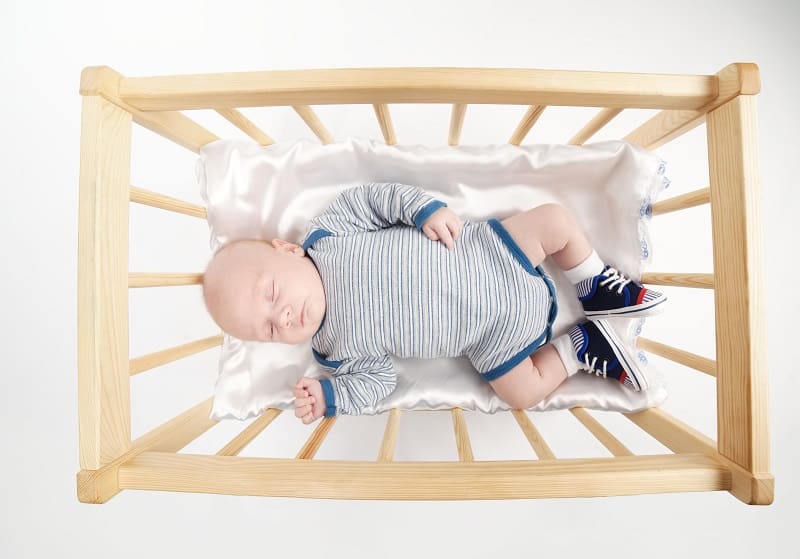
How long will my newborn sleep in the bassinet?
There’s no hard and fast rule – as long as they fit comfortably is the short answer. It’ll depend on how big your baby is, how fast she grows and how big the bassinet is or its weight capacity.
As a rule of thumb, you’re looking at somewhere between 2 and 3.5 months, but you’ll so know when it’s time to step-up to a crib.
For example, if baby is visibly bumping the side of the bassinet and looking cramped or, once out the swaddle, hands are touching the side of the bassinet (as was the case with my long-armed son) then you probably need to think about a crib.
Is it OK to leave a newborn in the bassinet awake?
Absolutely. Not while you go to the shops of course, but this is an ideal opportunity for baby to become more familiar with the bassinet, This also allows baby’s own smell to linger inside, since newborns are soothed and calmed by their own smell.
Once baby is awake for short periods outside of eating, the bassinet is an ideal place to let baby stretch and kick her legs or try a few minutes of tummy time, while you’re close by.
Can you sleep train a newborn?
This all depends on the definition of “sleep train”. If the “term sleep” train conjures up visions of strict schedules and leaving her to cry herself to sleep (Cry It Out) in an attempt to teach her to self-settle, then no, definitely not.
But encouraging good sleep habits, gently (i.e. with no tears involved) from the get-go can pay dividends. Some class this as “sleep training”.
So here we’re talking things like starting a bedtime routine and waking baby from day naps, both so she can eat and doesn’t sleep too much during the day (avoiding a hungry, lively baby at night). Oh, and let’s not forget trying to get that newborn to sleep in a bassinet.
For my top 10 gentle, no tears newborn sleep tips check out: 10 baby sleep strategies to get baby sleeping through the night
Why does my newborn wake up as soon as I lay them down in the bassinet?
If your baby won’t sleep in the bassinet, it’s probably due to a combination of reasons that relate to the huge change in the environment your baby experienced when born.
In the womb, your baby was snugly cacooned inside of you, in the warm and dark with the loud swooshings and wooshings of your body hard at work. In addition, they were gently rocked and swayed and jiggled, keeping that “calming reflex” almost permanently on.
Out in the big wide world, sleeping in your arms or on your chest is the next best thing. Your arms and body will provide several similar sensations that help keep your little one calm, content and easily able to fall asleep.
Unfortunately, anywhere else pales into significance and that includes the bassinet – hence often your newborn wakes up as you put her down.
But, hopefully, now you can have a good stab at figuring out how to get a newborn to sleep in a bassinet, with 15 different things to try. Don’t resign yourself to the fact that your baby only sleeps in your arms yet.
If you’ve skipped ahead, jump back to the main body of this article by clicking here: How to get your newborn to sleep in her bassinet instead of your arms
How do I teach my newborn to self-soothe to sleep?
During the early weeks and months of the newborn phase or fourth trimester, your baby probably won’t be ready or able to learn this skill, this ability comes around the 3-month mark. However, during this period rather than “teach” baby to self-soothe you can simply gently encourage it by:
#1 PAUSING
Pause for a moment or two when baby stirs, crys out or opens her eyes for 2 reasons:
- Babies are very restless sleepers, she may not be awake at all and you’re only going to disturb her by rushing in or picking her up
- Newborns often wake up when transitioning between sleep cycles or even between stages of one cycle – it doesn’t mean she needs to eat or that she’s not done sleeping. There’s every chance she’ll fall back to sleep, but only if you give her that chance! If she does fall back to sleep alone, she has self-settled or soothed. With time this will become a well-established habit and skill
Related post: The ONLY sleep tip you really to encourage baby to sleep through the night: to “pause”
#2 STARTING A WIND-DOWN ROUTINE
Combined with that all-important magical sleep zone (pitch black, white noise) the wind-down routine helps prepare for and signal to your baby that it’s time to sleep. (See earlier in the post for an example bedtime routine). By consistently carrying out the same routine each night, in time the last step of falling asleep will come naturally which means you can…
#3 PLACING BABY IN BASSINET SLEEPY BUT STILL AWAKE
This means that baby does the falling asleep part herself – again, with time this will become a well-established habit and skill

How do you calm an overtired newborn baby?
This one’s a toughie because overtiredness brings big tears. Not only will your baby be almost inconsolable, but harder and harder to settle to sleep the longer she stays awake. This is due to cortisol flooding your little one’s body in an attempt to help them stay awake when they actually need to sleep.
More on this and how to avoid overtiredness here: Baby fighting sleep? Overtired baby alert! 3 tactics to prevent overtiredness that really work
When baby is fussy and overtired, you want to initiate the “calming reflex” – check out #4 in the list above.
For more ideas on how to soothe and calm a fussy baby check out: Baby won’t stop fussing or crying? 7 winning strategies to calm and soothe
Can you do cry it out (CIO) with a newborn to get them to sleep?
No, absolutely not. You should never leave a newborn to cry for an extended period of time (more than a few minutes). Newborns cry to communicate their needs. They need to eat often and you need to “feed on demand” i.e. whenever they are hungry.
If it’s not food there are plenty of other reasons you might be needed: diaper change, trapped wind, pain or discomfort, comfort, help getting to sleep (since newborns are often unable to self-settle or self-soothe).
How can I get my newborn to sleep in the bassinet instead of my arms?
& How do I get my baby to sleep without being held?
Both of these questions should be answered in the main body of this post, so these those arm-saving, bassinet sleeping solutions and ideas are simply a brief recap:
- Ensure baby’s sleep environment is spot on (pitch black, white noise), swaddle baby and carry out a wind-down routine – all of which calm, soothe and prepare baby for sleep
- Make the bassinet as inviting/soothing/comfortable/sleep-inducing as possible by:
- heating the bassinet first or trying the washcloth trick
- introducing yours and baby’s smell into the bassinet
- supporting baby’s legs to help her adopt a back-lying fetal position
- trying the dry rice or tissue trick
- Invest in a Cacoonababy or Snoo
- Learn how to settle baby to sleep in the bassinet
Jump back to the main body of this article by clicking here: How to get your newborn to sleep in her bassinet instead of your arms
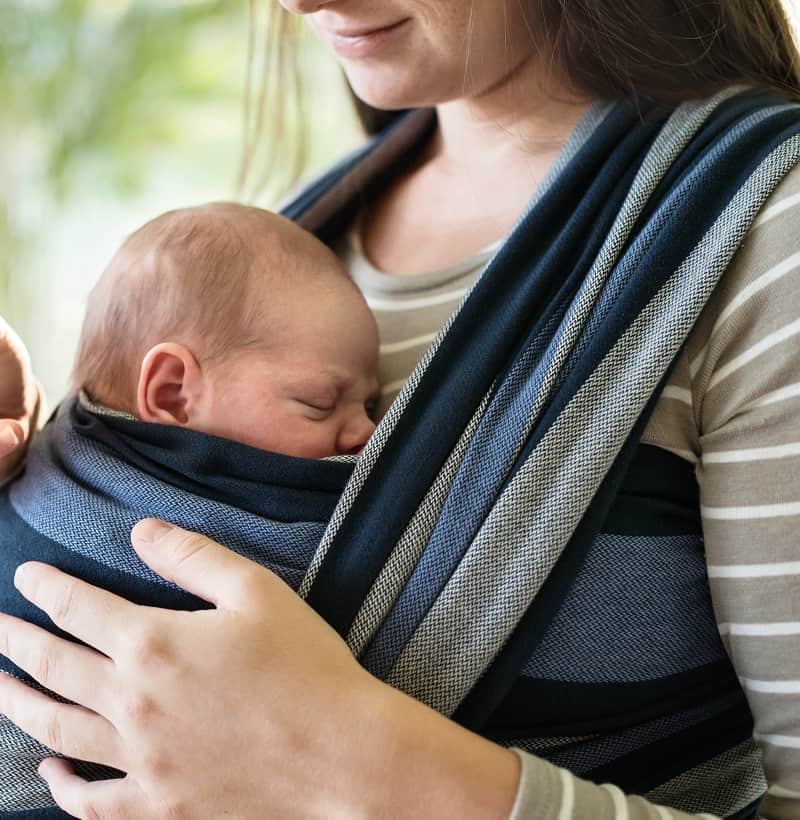
What do you do when your baby only sleeps in your arms?
If you’ve tried everything, as in all the solutions and ideas in this post for how to get a newborn to sleep in a bassinet and still you’re not winning, then take a break from trying.
I’m all for determination and perseverance – which you need in buckets to navigate the motherhood journey, particularly early on. But sometimes the feeling that you just have to do something adds to the stress and exhaustion.
You’ve probably discovered a few different ways to make the arm/chest sleeping more bearable – my favorite was a baby wrap or sling, at least giving me some hand-free time.
So carry on with whatever you need to do and then try again to get baby sleeping in her bassinet.
Getting your newborn to sleep in her bassinet may seem impossible but don’t give up
Easier said than done, I get it, but with consistency & perseverance your hard work will pay off.
Remember the key to all of this: to try and replicate as many of those womb-like sensations as possible by setting up the perfect sleep environment, ensuring a good wind-down routine. Then work on making that bassinet super inviting. (Of course, the sleep environment also needs to be safe too.)
These aspects may be the key to getting your newborn to sleep in a bassinet.
Last, but by no means least, placing your newborn in the bassinet and then settling her as described at #12 may be the way to go – there’ll be no waking up as soon as you put her down because she’ll already be down.
And remember, don’t panic if your baby won’t sleep in her bassinet – take a break from trying if you need and then have a crack at it again. In time, you will be able to get your baby to sleep in her bassinet instead of your arms.
Need more tips to help you with your newborn?
- Rooting to suck: is baby really hungry? And why you need to know (Hint: beware the comfort feed)
- How to tub bathe a newborn step-by-step & plus baby bath tips for fun, stress-free bathing
- How to help a newborn poop instantly! 11 tried & tested ways to relieve poopy struggles
- Newborns first bath: how to sponge bathe a newborn baby girl or boy with umbilical cord still attached
- When is it safe to travel with a newborn by plane or car? Plus the best newborn travel tips from a well-traveled mom of 4
- What should a newborn baby wear to sleep in bed at night? Newborn sleepwear de-mystified!
More baby sleep tips?
- Baffled by how much sleep baby needs? Baby sleep chart to the rescue!
- 10 tips for the 10-month sleep regression to help you navigate it with minimal sleep lost
- (Gentle) Sleep Training: What To Do When Your Baby Wakes Up Too Early In The Morning
- How to get your newborn to sleep in a bassinet instead of your arms with 12 different tactics
- Starting A Newborn Sleep & Feeding Schedule That You And Your Baby Will Love & The Ultimate Guide
- Fed-up with short naps? 9 tactics to take 2 hour naps from dream to reality
How about some nursery inspiration? Check out these posts:
- 49 Out of this World Space-Themed Nursery Ideas for Your Little One
- 23 Best Green Paints For Nursery (Sage, Dark, Hunter, Light)
- 75 Green baby nursery ideas: sage to olive, dark to light
- 49 Out of this World Space-Themed Nursery Ideas for Your Little One
- 35 Gorgeous nursery shelf & decor ideas
- 15 best rocking chairs & nursery gliders for small spaces in 2022
- 25 best nursery closet organization ideas in 2022 (plus exactly how to organize baby’s closet)
- 18 Best Blackout Shades/Curtains For Baby’s Nursery (2022 UPDATE)
- 15 Best baby bassinets for small spaces
- Baby bassinet vs. Co-sleeper: 5 important considerations
- 21 Best portable baby beds & toddler travel cribs in 2022
- 15 best zero-VOC baby-safe & non-toxic paints for a baby room or nursery walls
- 13 Best non-toxic safe paints for your baby’s crib in 2022






